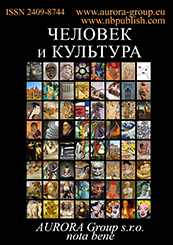Culture and cultures
Reference:
Litvintseva G.
On the Problem of Perception and Evaluation of Post Modernism by Russian Audience
// Man and Culture.
2014. ¹ 4.
P. 1-15.
DOI: 10.7256/2409-8744.2014.4.13493 URL: https://en.nbpublish.com/library_read_article.php?id=13493
Abstract:
In article the reasons of the negative relation of the Russian audience to a postmodernism are established. On concrete examples its unpreparedness to perception of post-modernist texts of literature and art connected with application to them estimated criteria of an era of a modernist style (critical and socialist realism) reveals. Also criteria by means of which the adequate assessment of post-modernist art texts is possible reveal. Texts in which artists and writers create absurd situations are considered, resorts to pathologies and blasphemy to show absurdity of surrounding life. The analysis of the conclusions on research of works of art allowed to reveal absence of knowledge at experts of language of a postmodernism and criteria of its assessment. At the same time in article researches of a theoretical and art postmodernism in which its objective assessment is carried out are allocated. The author comes to a conclusion that a postmodernism tries to comprehend crisis of modern culture critically. The knowledge of its language allows to carry out an adequate assessment of texts of literature and art. Post-modernist texts should be perceived as attempt of research of such questions, difficult for modern society, as tolerance, conformism, a tabuirovannost, freedom of creative self-expression and inadmissibility of an identification of art with religion and real life.
Theoretical culturology and the theory of culture
Reference:
portnova t.
Ballet and Sculpture (Theoretical Description of Expressive Language of Plastic Arts Through Synchronic Analysis)
// Man and Culture.
2014. ¹ 4.
P. 16-31.
DOI: 10.7256/2409-8744.2014.4.13544 URL: https://en.nbpublish.com/library_read_article.php?id=13544
Abstract:
As research the most indicative couple of plastic arts - ballet art and a sculpture is chosen. Nature of interaction of a sculpture and dance in aspect of its division into types and types is comprehended.Important elements of interrelations of the ballet and sculpture are considered: volume and countervolume, silhouette and invisible borders, foreshortening and composition, treatment of light and shade and form, spatial interval and plastic image. The esthetic nature of the plastic beginning in some statements of famous choreographers of XIX and XX centuries reveals. Concepts the plastic language, sculptural dramatic art, visual style entered by the author into research allow to perceive elements of choreographic expressiveness, it is good to feel all volume of scenic and graphic and plastic information. Article is focused on acquaintance with the conceptual device and methodology of synthetic research, in relation to research of adjacent arts. The typological system method allowed to reveal features of expressive language of ballet art and a sculpture, and the comparative analysis to designate points of intersection between them. For the first time the comparative analysis of language analogies of these types of creativity, identity of means of expression, parallels in creation of artistic images by means of similar composition methods, plastic forms, technical means and style decisions is given. The author's concept of article is consolidated to conclusions about the importance of work of the choreographer and artist with space and the three-dimensional image, visual dramatic art and dynamics of acting skills, confirmed with a number of statements from archival sources and memoirs materials.
Sociology of culture, social culture
Reference:
Polishchuk V.I.
Eternally young and irrepressible slavic peoples
// Man and Culture.
2014. ¹ 4.
P. 32-44.
DOI: 10.7256/2409-8744.2014.4.14129 URL: https://en.nbpublish.com/library_read_article.php?id=14129
Abstract:
Article is devoted idea of Slavic peoples, slavic identity which for many remains still attractive,¬ exciting and obliging to search for ways of the realisation. The author puts questions: in what its force why ¬ to it come back again and again? And why, despite its respectable enough age, in it the touch something decided, artificial and groundless is still felt¬? The idea of slavic unity is illusory, the author believes, this unity if will be carried out, only at the initiative of the power. It is used analytical and comparative research methods that is caused by necessity of revealing of ideological essence for understanding of a real value and finding-out of the historical status of Slavic peoples.
Keywords:
«a slavic science», vseedinstvo, Russia, Slavophiles, romanticism, panslavizm, Slavic peoples, history, originality, illusiveness.
Theory and methodology of communication
Reference:
Trofimova G.A.
Culture TV: pluses and minuses
// Man and Culture.
2014. ¹ 4.
P. 45-57.
DOI: 10.7256/2409-8744.2014.4.14062 URL: https://en.nbpublish.com/library_read_article.php?id=14062
Abstract:
The subject of the cultural process always since its inception was television. It plays an important role today. Meanwhile, it seems, television itself as a cultural community must meet certain principles: to show due respect for the audience, to the country's history, traditions and customs of the people living in it.However, the cultural aspect of modern television has both positive and negative features. Their study and author has devoted his article. To implement this goal used methods of formal analysis, comparison, modeling and observation. As a result of research the author has identified the main advantages of modern television and called it the defects related to the quality of the show, the choice of subjects shows and movies, using works of literature and cinema have long since become the cultural heritage of the people.It was concluded that the need to address the shortcomings of television show. And offered as a necessary action to create a kind of respect for the interests of the Code of spectators and follow him, as well as the proper administration of the national legislation.
Keywords:
television production., consumer protection, misrepresentation, copyright protection, the requirements for a TV presenter, television culture, television, culture of speech, advertising, television defects
Cultural heritage, tradition and innovation
Reference:
Shchuplenkov N.O.
Preservation of national and cultural identity and the search for new forms of emigration in the
// Man and Culture.
2014. ¹ 4.
P. 58-84.
DOI: 10.7256/2409-8744.2014.4.14130 URL: https://en.nbpublish.com/library_read_article.php?id=14130
Abstract:
The article discusses the main activities for the conservation of the national cultural identity of Russian emigrants of 1920–1930. Caught in a cultural environment, the Russian diaspora was forced to create new patterns of behavior are often conflicting with the former way of life that threatened social fragmentation, conflict with other countries, denationalization. Deep concern about the thinking part of the Russian diaspora loss of national ideals, national and cultural traditions determined the active search for spiritual scrapie. In today's Russian historical memory of the recent experience preservation of national and cultural identity of Russian emigrants of 1920–1930 may help to understand the best ways to the development of society.Retrospective method allows you to restore the historical space, against which there was a process of conservation of national and cultural identity.The role of Russian traditions of the Russian Orthodox Church in the formation and maintenance of national and cultural identity of immigrants. Highlighted several levels that make up the identity of the Russian emigrants, which allowed them a long time to maintain identity in a cultural environment: verbal, psychological and structural level and the cultural value of awareness. The role of the Russian emigration "cultural bridge" between Western civilization and Russia.
Keywords:
Russian Orthodoxy, Russian civilization, Russian emigrant diaspora, National mentality, National and cultural identity, Mission, Collectivism, Dialogue of Cultures, Self-identity, Subanthropology approach
 This work is licensed under a Creative Commons Attribution-NonCommercial 4.0 International License.
This work is licensed under a Creative Commons Attribution-NonCommercial 4.0 International License.









 © 1998 – 2024 Nota Bene. Publishing Technologies. NB-Media Ltd.
© 1998 – 2024 Nota Bene. Publishing Technologies. NB-Media Ltd.




